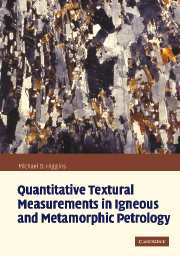Book contents
- Frontmatter
- Contents
- Acknowledgements
- 1 Introduction
- 2 General analytical methods
- 3 Grain and crystal sizes
- 4 Grain shape
- 5 Grain orientations: rock fabric
- 6 Grain spatial distributions and relations
- 7 Textures of fluid-filled pores
- 8 Appendix: Computer programs for use in quantitative textural analysis (freeware, shareware and commercial)
- References
- Index
3 - Grain and crystal sizes
Published online by Cambridge University Press: 08 August 2009
- Frontmatter
- Contents
- Acknowledgements
- 1 Introduction
- 2 General analytical methods
- 3 Grain and crystal sizes
- 4 Grain shape
- 5 Grain orientations: rock fabric
- 6 Grain spatial distributions and relations
- 7 Textures of fluid-filled pores
- 8 Appendix: Computer programs for use in quantitative textural analysis (freeware, shareware and commercial)
- References
- Index
Summary
Introduction
One of the most commonly quantified aspects of rock texture is the size distribution of crystals, grains and, more rarely, blocks. Although the first published study of crystal size in igneous rocks was in the early days of petrology (Lane, 1898), the subject really only took off in 1988 after the publication of seminal papers by Marsh and Cashman (Cashman & Marsh, 1988, Marsh, 1988b). In metamorphic petrology the study of size distributions started a bit earlier with the study of garnets by Kretz (1966a). The importance of grain size distribution in sedimentology completely outweighs that of other branches of petrology and is covered in more detail in sedimentological texts (e.g. Syvitski, 1991). Engineers have a considerable interest in the mechanical and chemical properties of materials (Brandon & Kaplan, 1999): grain size and composition play an important role in controlling these properties and hence their quantification is very important (Jillavenkateas et al., 2001, Medley, 2002). Also of interest are pore and bubble sizes in rocks and these are discussed separately in Chapter 7.
What are size and size distributions?
The size of a crystal or grain is a measure of the space occupied by the object. It is a three-dimensional property and can be defined in several different ways, according to the application of the parameter: if the shape of a crystal changes during growth or solution then a volumetric measure of size may be useful. Size based on volume is simple because every grain has a unique volume.
Information
- Type
- Chapter
- Information
- Publisher: Cambridge University PressPrint publication year: 2006
